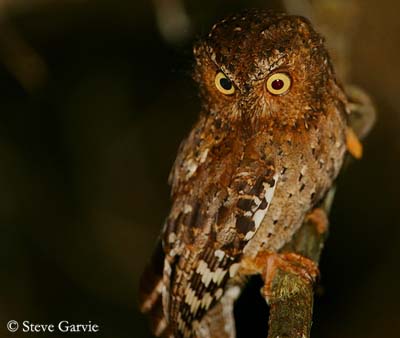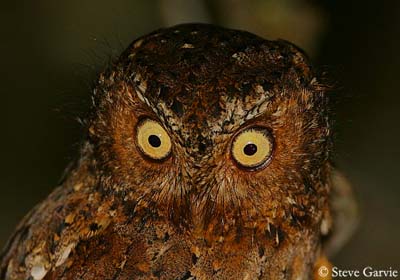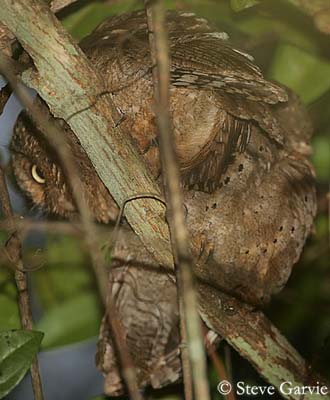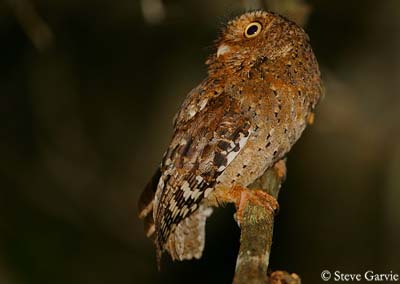
Sokoke Scops-Owl
Otus ireneae
Strigiforme Order – Strigidae Family
BIOMETRICS :
Length: 15-18 cm; Weight: 45-50 g
DESCRIPTION:
This small owl occurs in several morphs, such as dark brown, grey-brown and rufous. Vulnerable species living in very restricted range, it has been discovered in 1965.

In all morphs, adult has finely spotted upperparts. Upperwing shows fine vermiculations on coverts, whereas flight feathers are barred with pale buffy-white and brown. Tail is indistinctly barred with dark and pale bars.
Underparts are paler. Breast is slightly darker, and we can see some blackish spots.

On the head, Sokoke Scops-Owl has small ear-tufts, not conspicuous. The crown is streaked with dark brown. Nape is spotted with pale feathers’ edges. The facial disk is pale rufous, with brown and buff. Eyebrows are paler, whitish to buffy.
The bill is usually horn-coloured, sometimes blackish, with yellow cere. Eyes are yellow. Legs and feet are grey to brownish.
Both sexes are similar.
Juvenile resembles adults.
VOICE: SOUNDS BY XENO-CANTO
Sokoke Scops-Owl utters 5 to 10 notes per series, a whistled “too-too-too-too…”. Usually, these phrases are repeated up to 10 times per minutes. It is mostly heard before dawn and after dusk.
HABITAT:
Sokoke Scops-Owl lives mainly in tropical coastal forests where Cynometra and Brachylaena are growing. It can be found from sea-level up to 70 metres of elevation, and locally between 200 and 400 metres.
This species avoids the adjacent miambo woodlands (tropical and subtropical grasslands, savannahs and scrublands).
RANGE:
Sokoke Scops-Owl lives in very restricted area in Kenya and Tanzania, and particularly in Sokoke-Arabuko Forest in south-eastern Kenya and north-eastern Tanzania.

BEHAVIOUR:
Sokoke Scops-Owl feeds mainly on insects, sometimes at dusk, but mostly at night. It is a nocturnal species. It usually hunts from a perch at about 3 to 4 metres above the ground, from where it drops onto its prey. Its large yellow eyes give this bird very good eyesight at night.
Sokoke Scops-Owl sleeps during the day, resting in thickets. Its cryptic plumage allows it excellent camouflage. When resting, it compresses the body, but it erects the ears while the eyes are almost closed, as a split.
Sokoke Scops-Owl is sedentary, but it performs some dispersal, probably according to the food resources.
It is solitary or seen in pairs. As other cavity nesters, it is very territorial all year round and defends the nesting-site within its small area.
FLIGHT:
As the other Strigidae, Sokoke Scops-Owl has silent flight, provided by the leading edges of the outer flight feathers of which the fringes deflect the air upwards, passing over the wings during the flight.

REPRODUCTION:
Breeding and nesting behaviours of Sokoke Scops-Owl are unknown. But this species nests in natural cavities such as holes in trees, and particularly in Brachylaena trees.
DIET:
Sokoke Scops-Owl feeds mainly on insects such as crickets and beetles. It hunts from a perch, swooping down onto its prey. Its keen eyesight allows it to hunt at night.
PROTECTION / THREATS / STATUTS:
Sokoke Scops-Owl is listed as vulnerable species. This owl lives in very restricted area, but in suitable wooded habitat with Cynometra, the densities of this species seem to be relatively stable.
However, Sokoke Scops-Owl is heavily threatened by habitat loss and removing of dead wood.
The Arabuko-Sokoke Forest is the only natural Coastal Forest in East Africa, and this area shelters numerous species found only there.
This forest is threatened, but it would be possible to keep it by creating a situation of harmony between humans and wildlife. With the survival of this forest, the owls will survive too.
This species is listed as endangered, threatened by the loss of suitable habitat, and by the removal of its main nesting habitat, the large Brachylaena trees.
Efforts and conservation programs are in progress with the Arabuko-Sokoke National Park, in order to protect this area.
Fr: Petit-duc d’Irène
All : Sokokeeule
Esp : Autillo de Sokoke
Ital : Assiolo di Sokoke
Nd : Sokoke-dwergooruil
Russe : Совка кенийская
Photos de Steve Garvie
RAINBIRDER Photo galleries
Texte de Nicole Bouglouan
Sources:
HANDBOOK OF THE BIRDS OF THE WORLD Vol 5 by Josep del Hoyo-Andrew Elliott-Jordi Sargatal - Lynx Edicions - ISBN: 8487334253
Wikipedia (Wikipedia, The Free Encyclopedia)
BirdLife International (BirdLife International)